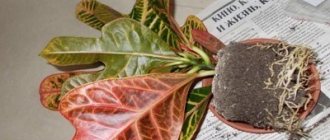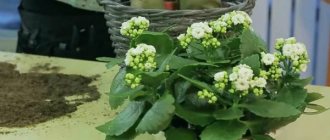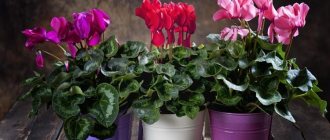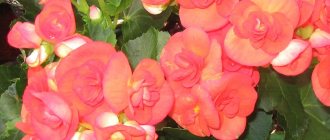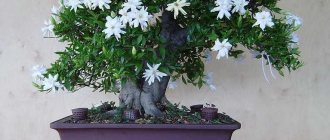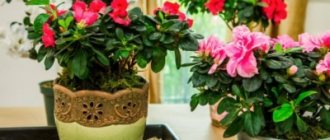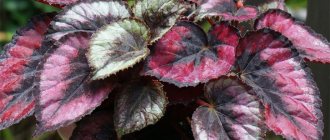Croton (or codiaum) is a houseplant distinguished by its unusual beauty.
The following types of Croton are very popular among gardeners: Motley, Petra, Excellent, Tamara.
At the same time, this is a very capricious flower that requires special care.
It should not be replanted more than once every 2-3 years.
Since replanting is difficult for , you need to know all the features of the process: when is the best time to carry it out, what kind of soil and pot is best to use, and much more.
Peculiarities
Croton is replanted once every 2-3 years ; in some cases, replanting is allowed after 4 years.
Croton should not be disturbed during the flowering period. Therefore, the optimal time for transplantation is March. It is at this time that the growing season begins.
Transplantation after purchase is very important for codiaum; it is best to do it as soon as possible.
The substrate in which the flower “lived” in the store and during transportation, at home, can lead to the leaves drying out and falling off, other Croton diseases, and even the death of the plant .
Croton is replanted for several reasons:
- becomes depleted over time and needs to be replaced;
- The root system develops and there is little room for it in the pot. Therefore, a sign that it is time to move a flower is the appearance of roots on the surface of the ground.
Each subsequent one should be 2-3 cm larger than the previous one . You should use plastic or clay ones.
Garden varieties
Kalanchoe calandiva: home care, propagation, replanting after purchase, pruning and flowering
These are lush, spreading bushes or trees with large, bright leaves that can decorate a winter garden or greenhouse. If you create conditions close to tropical for the plant, you can get large specimens that will delight you with bright colors and a variety of shapes of leaves and stems.
The most suitable for growing in a greenhouse is variegated croton (pictum), as it is less demanding in care. The challenges of caring for hybrid species come down to the amount of light and humidity the plant receives.
Codiaum can get by with little sun and little watering, but it takes effort to get a truly beautiful tropical plant.
Transplant instructions
The soil must first be prepared. Its composition depends on age.
For young plants, the soil for replanting consists of coarse river sand, leaf soil and turf soil, mixed in a ratio of 1:2:1. For an adult, the ratio is 1:3:1, respectively.
You can also use soil purchased at the store. It is recommended to add a little leaf soil to it Before planting, the soil should be shed with a weak solution of potassium permanganate and dried.
Drainage
must be placed at the bottom - expanded clay or clay shards. It should fill ¼ of the pot.
After preparing the pot and soil, you can begin replanting the croton:
Drainage is laid at the bottom , soil is poured on top. The earth is moistened and a depression is made in the center.
The croton is removed from the old one. You need to pull it out carefully . You cannot disassemble its roots and remove soil from them. The plant is transplanted together with a lump of earth.
The exception is a flower that is replanted after being purchased in a store. You need to shake off as much substrate as possible from the roots of such a croton. However, disassembling the roots is also not recommended;
An earthen ball with roots is placed in a recess in the new one and covered with the remains of the new soil. There should be no voids in the pot , so the earth is slightly pressed down;
The transplanted croton is watered. After transplantation high humidity , so it needs to be watered daily . also recommended to spray it with a spray bottle.
Seedlings (dividing the bush)
Sometimes the plant becomes too crowded in the pot. In this case, it is necessary to propagate the croton (plant).
The process is also recommended to coincide with the beginning of spring.
Pots with drainage and substrate (soil for young and adults) are pre-prepared. The day before transplanting, the plant is watered abundantly.
Seating is carried out as follows. The codiemu bush is removed and divided into several parts : the main plant and root children . A large bush is planted in a large pot with soil for an adult plant.
Small shoots are placed in small pots with soil for young flowers, covered with plastic wrap and placed in a warm place.
Briefly about croton
Another name for Codiaum is a perennial plant that belongs to the Euphorbiaceae family. Quite beautiful, but requires attention and knowledge of care features.
The name of the flower itself comes from the ancient Greek city and means “head”. There are several versions of the origin of this name, but many are inclined to believe that its authorship belongs to the botanist Georg Rumphis.
One of the most important questions that every gardener should ask himself when purchasing is: how to replant croton?
There are several methods, but one of the best is the transfer method - transferring the plant along with a lump of soil into a new container. First, a new drainage layer of charcoal and expanded clay must be placed in the pot.
Young plants need to be replanted every year, but flowers of older generations should be replanted no more often than once every few years. It is also important to take into account that when replanting, a complete replacement of the soil is not recommended, since the root of the codiaum is very thin and difficult to adapt to changing conditions.
The flower does not need too large containers; it is important that the root fits and does not bend at the bottom. When choosing a flowerpot, you should focus on both ceramics and plastic. However, there must be holes at the bottom of the container to allow excess water to escape. Otherwise, the root may begin to rot.
This is a delicate plant that requires special attention. However, if you take into account all the nuances and look after it properly, the flower will certainly please the owner.
Description
In nature, croton is found in the tropics of India and Southeast Asia. The second name for croton is codiaum, which comes from the Euphorbiaceae family. Translated from Greek, the word codeia means head. A little unclear, but nonetheless a fact.
It is distinguished by its oval, slightly elongated shape of leathery, dense leaves. Leaves of various shapes have a wide variety of shades.
Croton is also popularly called indoor oak; it can have not only variegated leaves, but also light green, yellow - very different hybrid varieties have been bred by breeders.
A characteristic feature of croton leaves is the ability to change the color of the foliage, but not at all due to the change of seasons, but everything depends on age-related changes. Codiaum blooms with completely inconspicuous, small flowers; it is better to remove them due to the lack of decorativeness, but croton did not waste energy on their development.
The developed varieties of croton differ in leaf shape:
- appendage - a leaf of green or variegated color, has a bridge, consists of two parts.
- lobed - the leaves have a three-lobed shape, the middle part is somewhat elongated, up to 20 centimeters, has stripes and spots.
- flat-leaved - large oval leaves have wavy edges.
Codiaum variety Mammi
It has narrow and small leaf blades, their edges are smooth and wavy. The leaves curve along the central vein. The color of croton can be completely different; even on one specimen you can find leaves of both red and green with pink and yellow spots.
Codeium Excellent
This croton has leaf blades shaped like large lobes. The color of the leaves is green with yellow veins. The inner side of the leaf is red and has brownish veins.
Croton Mrs. Eyeston
Croton Mrs. Iceton has leaf blades that are quite wide, but short. On younger plants the foliage is a soft cream color.
As they get older, the leaves change color to pink or bright red with lots of splashes of yellow. In some specimens you can see leaves of a very dark, almost black color.
Codium Mix
This type of croton is distinguished by the presence of a mass of subspecies. It has pointed, long leaf blades that grow up to 20 centimeters. There are even varieties with 30 centimeter leaf blades.
Croton Sunny Star
Its leaf blades are green, and the tops themselves are yellow. The leaves have a slightly pointed, lanceolate shape. Young leaves are bright green with yellow veins.
Codiaum aucubifolia
It is very popular among gardeners for indoor growing. The leaf blades are unevenly colored, with yellow-green tints. The leaves are medium sized, rather narrow.
Croton: description, reproduction and care, video:
Is it necessary to replant Croton after purchase?
Most of the flowers that arrive on store shelves either arrived from abroad in a specialized substrate for transportation, or were grown in industrial conditions.
In both cases, the substrate on which the flower grows at the time of purchase is not suitable for long-term cultivation, because:
- It is not suitable for irrigation and under the influence of water it only gets wet, not allowing the necessary oxygen to pass through;
- Stopping air access leads to the formation of rot on the roots;
- On it, during transportation, the plant suffered too much stress, which can negatively affect the condition of the codiaum.
Instead of an afterword
Many gardeners consider croton to be a capricious plant. All difficulties with its cultivation arise due to improper care. The slightest mistakes cause a violent reaction. This whimsical, handsome creature is a tropical resident; it is not surprising that it is not easy for him to take root in our area. Croton, with proper care, can grow well in a home for up to ten years. A perennial plant in the hands of experienced gardeners can reach impressive sizes.
The main value of culture lies in its decorativeness. With proper care, croton pleases with variegated foliage and large leaves. The plant is not prone to disease due to its toxicity. And yet, with a lack of watering and air humidity, crotons can become capricious and get sick. This means that simply following the rules of care will help you avoid trouble.
Source
How often should croton be replanted during cultivation?
Depending on the age of the flower, the need for replanting varies:
- It is recommended to replant mature ones no more than once every three years, as the root system grows. In this case, it is worth considering that the diameter of the new pot should be three to five centimeters larger than the old one. Don't buy too large a container;
- Young ones need annual transplantation in the spring, or in extreme cases, summer, period.
Before transplanting into a new container, it is recommended to add new fertile soil.
If you are not sure that you know exactly how and when to replant codiaum, you should not experiment. There is a high risk of damaging the plant.
In addition, during the growing process you can change the shape of the flower. By pinching off the top shoot, giving it the shape of a bush. However, it is worth considering that in this case, the formation of the crown will occur more slowly, since the lateral branches grow more slowly than the axial stem.
Before you start transplanting, it is recommended to familiarize yourself with its features. Colodium is a capricious flower that needs close care and neglect can lead to its death.
Possible problems
The beauty of the foliage is the main advantage of the indoor croton flower. We told you how to care for it earlier. Compliance with all the rules will avoid problems. If there is something wrong with the plant, look for mistakes made in its care. Eliminating them will help return the bush to its previous state.
Why do Croton leaves fall off? The flower can shed foliage at the bottom of the trunk. This process is natural. In this case, there is no need to worry if all the other foliage is in order.
If you notice that the tips of the leaves are drying out, causing them to fall off later, this indicates low humidity levels in the house. The tropical beauty does not have enough moisture, and it dries out.
When the plant is kept in low temperature conditions, the edges of the leaf plates dry out. Brown spots may also form. This phenomenon occurs if the plant suffers from cold, which leads to leaf fall. A similar picture can be observed when the bush is in a draft.
If croton does not receive the required amount of moisture through watering for a long time, it begins to dry out en masse and shed its leaves. Since the root system does not receive enough moisture, it cannot provide it to the entire plant.
Sometimes croton drops its leaves. Why is this happening? This situation is the plant’s reaction to cold. When the roots are cold, they do not supply moisture to the plant. The flower pot must be moved to a sunny, warm place and watering must be arranged. During the periods between moistenings, the soil in the peas should dry out a few centimeters. Until the situation normalizes, you should not feed the plant. It must be sprayed with water and wrapped in a transparent bag.
Loss of foliage elasticity indicates excessive soil moisture. Abundant and frequent watering does not allow the soil to dry out. Sometimes the stem may even rot. But the most dangerous thing is rotting of the root system. Therefore, it is very important to follow a watering schedule.
Sometimes crotons don't want to grow at all. Why is this happening? This situation occurs if the plant does not have enough light. For a tropical dweller, the sun is the basis of life. To improve the situation, the pot should be moved to a more illuminated place.
Sudden leaf fall is possible if the plant is watered with cold water. Croton prefers warm watering. During the cold season, the water needs to be heated a little.
There is no need to worry if the young leaves on the bush are not decorative. This is normal. New foliage is usually a dull yellow or green color and becomes variegated as it ages.
What soil is needed, what fertilizers should be used
Crotons, including young ones, need fertile soil. In addition, it is important to enrich the soil with fertilizers during intensive flower growth. Almost any complex fertilizer intended for indoor deciduous plants is suitable for feeding.
It is recommended to fertilize the substrate after watering.
Since codiaum comes from the tropical zone, the substrate must correspond to the characteristics of this area.
Fortunately, preparing it is not so difficult; to do this, you need to add the following to the ground in equal proportions:
In addition, it is recommended to freeze the finished substrate before transplanting. This will prevent the development of harmful bacteria that cause diseases and destroy pest larvae.
When laying the soil, you need to place some fine charcoal in it. This is one of the best methods of protecting roots from rot.
With the correct composition of the substrate, codiaum will easily replant and will not cause any inconvenience to the owner.
Croton propagation by leaf
The most common method of propagation is buried shoots. To do this, use one of the branches of the mother colodiaum, which is sprinkled with soil. After some time, it should take root and the seedling is ready for transplanting.
For a plant such as codiaum, propagation by leaves or apical cuttings is not particularly common, but some gardeners also practice it.
To do this you need:
- Choose strong cuttings up to fifteen centimeters long;
- Place in a container with a mixture of water and charcoal;
- Wait until the secretion of milky juice in the cut areas completely stops;
- Remove the cuttings from the water and let them dry;
- Plant in prepared soil. Maintain greenhouse conditions until rooting.
The best time to propagate croton leaves is spring. After the cuttings take root, it is recommended to place them in a well-ventilated area and spray them every day.
After a month, the seedlings can be planted in separate containers.
Leaf propagation is one of the methods used. It is recommended to carry out such seating in the spring.
Air layering
You've probably noticed that crotons often have bare trunks. This phenomenon affects the decorativeness of the bush. But don't be upset. From the plant you can get air layering for a young plant. To do this, in June, at a distance of approximately 10-15 centimeters from the top, a circular incision up to 0.8 cm wide is made on the stem. The cut site is certainly treated with a stimulator so that roots form faster. You can also use sphagnum moss, which is wrapped around the plant. The top cut is covered with film and tied with a rope. The oilcloth should not be attached too tightly on top so that the moss can be regularly moistened. The first roots will appear in about a month. But you can cut the cuttings only after the roots have grown to five centimeters. The layering usually retains many leaves. To maintain their vital functions, you will need a good root system.
The cut cuttings are planted in a pot with prepared soil. The seedlings are placed in a shaded place for two weeks. During this period, the plant must be sprayed frequently. It is still very weak, so it cannot receive the required amount of water through the roots.
Layers can be obtained in another way. The lignified shoot is pressed to the ground and sprinkled with soil in this state. To speed up the development of the root system, you can remove the bark from the bottom of the branch. After young leaves emerge from the ground, the new plant can be separated from the mother one.
Features of care, pruning croton
For the croton plant, pruning or pinching is a method of forming a flower crown. The top branches are often pruned to form side shoots.
After pruning, it is recommended to treat the cut areas with charcoal powder for disinfection.
It is better to trim only flowers that have reached twenty centimeters in height. Cut branches can be used for further propagation.
In addition, it is necessary to trim dry branches or shoots damaged by pests. Pruning codiaum is an important measure aimed at forming the crown or getting rid of the affected parts.
Croton is a houseplant of amazing beauty. Capricious, it requires a lot of attention during transportation and care, but if the rules are followed, it will delight the owner with a fresh look for a long time.
More common information about caring for croton - when watching the video:
Lighting
The plant needs bright, diffused light. Croton can withstand even direct sunlight.
Moreover, the brightness of the color of the leaves depends on the intensity of the light.
A sufficient level of lighting is especially important in winter , since it is this factor that leads to the falling of leaves.
To prevent the plant from losing its decorative appearance, it is necessary to move it to the most illuminated southern window sill. In winter, you should also increase the daylight hours for this flower. Illuminating croton with special electric lamps gives good results.
Video
We offer the opinions of experienced flower growers on the choice of the most interesting varieties and the need to pinch hanging petunias:
About the author:
Found a mistake? Select the text with the mouse and click:
Ctrl + Enter
Do you know that:
You need to collect medicinal flowers and inflorescences at the very beginning of the flowering period, when the content of nutrients in them is highest. Flowers are supposed to be picked by hand, tearing off the rough stalks. Dry the collected flowers and herbs, scattered in a thin layer, in a cool room at natural temperature without access to direct sunlight.
Temperature
Codiaum is thermophilic and does not like sudden changes in temperature. The flower reacts to such changes by dropping leaves.
The optimal temperature for keeping codiaum is considered to be 22-25 °C. The flower does not survive well when the temperature drops below 18 °C.
The flower requires stable temperatures throughout the year. In winter, it cannot be reduced, as this can lead to loss of leaf mass, which is very difficult to restore.
Even if it is cold in the apartment in winter, you should not place a pot with a plant near heating radiators. The radiator will create uneven heating, which can cause leaves to yellow and fall off. Place the flower in the part of the room where the temperature is most stable. You should also be wary of cold drafts.
The soil
For planting, you can buy a ready-made soil mixture for decorative foliage plants or make it yourself from equal parts:
Fertilizing of codiaum is carried out during the period of active growth 2 times a week. To do this, you can use fertilizers for decorative foliage plants.
The soil for codiaum should be fertile, but easily permeable to water. To do this, use coarse sand as a leavening agent. You can replace it with other components: perlite or vermiculite.
The plant grows best in slightly acidic soils. Peat is needed to acidify the substrate. When using store-bought soil mixtures, you need to make sure that peat is included in their composition.
Hydration
Watering the plant should be moderate. The soil should be slightly moist, but without stagnation of moisture at the roots. For watering you need settled, soft, warm water. Settling can be replaced by filtration.
The moistening process should include daily spraying and wiping the leaves on both sides. Croton is a moisture-loving plant; it should not be placed near heaters.
Trimming / Support / Garter
The easiest way to form a plant is throughout the year.
Codiaeum tends to grow a central stem, so to get a compact spherical bush, you should periodically pinch the apical bud.
Single-stemmed codiaums can be pruned at a height of 15 cm to force them to branch.
Pruning of adult plants is carried out for the purpose of rejuvenation, or to obtain planting material.
During spring pruning of an adult branched bush, it is necessary to remove dry and weak branches. Also, if there is a lack of light in winter, the shoots of the plant may stretch. All elongated ugly branches are cut off by 2/3. Strong and very long shoots should also be cut by half or 1/3.
A properly formed codiaum bush looks like a small lush tree. It does not need support or garter.
Diseases
Poisonous milky sap does not repel all pests. Plants are often damaged by spider mites, thrips, scale insects and mealybugs.
The color of the leaves makes it difficult to detect pests , and they are noticed only when yellow spots appear on the leaves.
A good way to prevent the appearance of pests is to regularly care for the leaves, spraying, maintaining high air humidity and periodically inspecting the plants.
Diseases are usually caused by poor care.
Insect pests of codiaum
The most common pests for codiaum, which can attack a beautiful flower and even destroy it in the absence of health measures, are:
- Spider mite.
- Shield.
- Chervets.
- Multi-clawed mite.
Spider mites are red and small in size. As a rule, it lives on the underside of the leaf, entwining the surface with a white thin web. If this pest infests a plant, small white dots and spots appear over the entire surface of the leaves. If the mite is not removed in time, there is a possibility of the flower drying out. To eliminate it, it is necessary to disinfect the entire surface of the plant using tobacco infusion with laundry soap, then rinse well with warm water and treat with ground sulfur or a ready-made store-bought preparation (insecticide). Spider mites can cause the leaves of codiaum to dry out.
Scale insects are a pest that causes dark brown spots to appear over the entire surface of the plant. It reproduces very rapidly; adult individuals sit motionless, covering themselves with “shields” from which small larvae crawl out. As they spread, they infect an increasingly larger area of the flower. To eliminate this pest, simply moisten a cotton pad with soapy water and manually remove all areas of infection. This procedure should be carried out repeatedly until the pest is completely eliminated.
Eggworm - appears very often in an indoor flower called codiaum in the form of white waxy discharge on the veins of the leaves and petioles of the plant. The pest is very miniature in size and lives in colonies. To eliminate it, it is necessary to isolate the plant from other house flowers and begin to treat the affected areas with mineral oil, under the film of which the worm will suffocate. The procedure must be carried out in dim sunlight and until all pest colonies are eliminated.
Multi-clawed mite - the main sign of this pest is the appearance of brown crusts on the petioles of the plant and the cessation of growth of leaves at the ends of the shoots, their roughness and curling down. To combat this pest, it is enough to treat the plant with mineral oil, or laundry soap, or a ready-made store-bought preparation (Fitoverm, Vertimek, etc.).
Below are photos of varieties of codiaeum diseases and its most common pests, from which you can study in detail what the external signs of damage look like:
Reproduction
Let's look at how codiaum reproduces. Propagation can be carried out by seeds and cuttings. The seed method is suitable for adult flowering specimens, on which seeds set and ripen.
Seed germination rate drops very quickly , so seedlings can only be obtained from freshly collected seeds. They should be sown superficially, as they require light to germinate.
With this method of propagation, it is impossible to predict what young plants will look like, but among them there may be very unusual specimens.
The easiest way to propagate codiaum is to root apical cuttings.
To do this, cut off the top 10-15 cm long, shorten the leaves or roll up a tube and place the cutting in a greenhouse for rooting.
Roots form best at high humidity and soil temperature of 25-30 ° C, after treatment with rooting stimulants. Rooting in water is also possible.
Secrets and difficulties of caring for codiaum at home
Codiaum is a very capricious and finicky plant. It must be grown only according to established rules. Otherwise, the flower begins to lose its decorative and aesthetic value.
Basic rules of care
The basic rules for caring for codiaum are presented in the table.
| Care criterion | Recommendation |
| Lighting | Sunlight in the morning and evening, at noon - bright diffused light. |
| Air temperature | Vegetation – 20-22℃; rest period – not lower than 16℃. |
| Humidity level | High level of humidity (from 75%). |
| Watering | Moderate. Frequency: every other day. |
| Top dressing | From April to November - 2 times a month, the rest of the time - 1 time a month. It is recommended to use complex mineral fertilizers for decorative deciduous plants. |
| Rest period | Winter. |
| Substrate | Turf soil + leaf soil + sand + humus in equal proportions. |
| Drainage | Expanded clay, small crushed stone, broken brick. |
| Flower pot | Deep with drainage and a tray for water drainage. |
Diseases and pests
Codiaum is susceptible to attacks by scale insects, aphids and spider mites. The infected plant is treated with a solution of any insecticide, for example, “Thunder”, “Grizzly”, “Fly-eater”. For heavily infected flowers, the treatment is repeated several times.
Codium diseases
This flower signals its problems through its leaves. Drying tips indicate a low level of humidity or air temperature in the room. Drooping leaves indicate waterlogging of the soil. If the air in the room is too dry, as often happens during the heating season, the flower may well shed all its leaves.
How to propagate and replant a flower at home
Young plants require annual replanting. Adult codiaums are replanted as the roots fill the pot space, but at least once every 3 years. Transplantation is carried out using the transshipment method. The remaining voids in the pot are filled with fresh soil.
At home, the flower can be propagated in three ways:
- cuttings;
- seeds;
- layering.
Please note! It should be noted that cuttings are the most common method of propagating codiaum. Moreover, the flower can be propagated using this method all year round.
Layerings are done no later than 3 months before the planned transplant. It is recommended to sow the seeds of the plant in February.
Apical cuttings
You can obtain codiaum from cuttings in the following way:
- A large leaf is cut from the mother bush and placed in water for 1-2 hours (to drain the juice).
- Then the leaf is rooted in a peat-sand mixture (1:1), and the soil is abundantly moistened.
- A cap is placed over the cutting (a cut-off bottle made of transparent plastic is suitable for this).
Propagation by apical cuttings
Every day the cuttings are moistened and ventilated for about half an hour. Rooting occurs after 1.5-2 months. As soon as the cutting produces a couple of young leaves, it is replanted as an adult plant.
Layerings and seeds
Some flower hybrids branch. These species can be propagated by layering. To do this, the woody vine is pinned to the soil using a staple. The top of the vine should remain exposed to the air. The top section of the vine with the bracket is sprinkled with soil. When transplanting, the rooted vine is cut off from the mother bush, planting it in the ground as an adult plant.
In order to remove codiaum from seeds, you must proceed as follows:
- Before planting, the seeds are soaked in a growth stimulator for a day.
- Then they are sown on a sand-peat mixture (1:1). There is no need to bury the seeds. Simply trample them with your fingers.
- The soil with seeds is irrigated using a spray bottle. The container is covered with film.
Scheme for rooting croton using air layering
Caring for seedlings is similar to the care described above for cuttings during the rooting period. The first shoots appear 3 weeks after sowing.
Transfer
When planting and replanting, you should not choose a pot that is too spacious; it should correspond to the root system of the plant or be 1-2 cm larger in diameter than the previous one.
The best time to transplant codiaum is spring or summer.
Young plants that are actively growing leaf mass require annual replanting, and in some cases it is worth transferring the plant to a larger pot twice a year.
Adult plants are transplanted only after the pot is completely filled with roots. A good indicator that replanting is necessary is the size of the leaves. If the young leaves are smaller in size than the old ones, then it’s time to transfer the plant to a larger pot.
Usually the plant in the store is in a transport pot. It is not suitable for keeping a flower in it for a long time. Therefore, after purchasing codiaum, it needs to be transplanted into a permanent container.
You cannot replant the plant right away; you need to make sure that it is in good condition. Therefore, croton transplantation after purchase is carried out 2-3 weeks after purchase.
Before transplanting croton at home, purchase a permanent pot. It should be shallow so that its width is greater than its height. A drainage layer at least 3 cm thick is placed at the bottom of the pot, and a little fresh soil is poured on top.
Croton is replanted using the transshipment method . It is removed from the transport pot along with the soil and planted in a new pot. Fresh soil is added to the sides of the earthen ball. After transplantation, the plant is watered moderately.
Photo of a codiaum (croton) flower in the process of care at home and in the natural environment:
- Author: Maria Sukhorukikh
Rate this article:
- 5
- 4
- 3
- 2
- 1
(0 votes, average: 0 out of 5)
Share with your friends!
Types and varieties
Codiaum variegated or variegated, as a synonym. Under natural conditions, this species can reach over two meters in height, and some up to six meters. Such tall species, more like trees, with bare stems about 70 cm.
The leaf length is about 30 cm, arranged alternately. The leaves are variegated in color with bright sunny, scarlet or green veins. This species is characterized by a different shape of the leaf plate. It can be wide linear, oval oblong, like a blade and similar in shape to a guitar. The edging of the leaves can be in the form of a wave, twisted, or spiral.
The plant of this species is dioecious. The female and male traits of the inflorescences are different. Females do not have petals, while males have a corolla and a calyx.
Codium "Petra" is a species with even branched shoots and large sinewy leaves that grow alternately. The shade of the leaves is a contrasting dark olive, with a variegated yellow edging along the leaves and veins of this shade.
Codium "Excellent" this species has leaves in the form of blades. The shade of the leaves on the surface is greenish with yellow veins along the leaf, and on the inside it is red with brown veins.
Codium "Mammi" This variety has leaves that are narrowed and elongated with a slight curl, in a spiral shape. The shade of the leaves is very catchy, scarlet with pink and yellow veins in alternation with red.
Codiaum "Sunny Star"
In this species, the shade of the leaves is mostly sunny tones, but the top and edges of the leaves are olive in color. Young leaves have beige tones, and over time they turn into scarlet, sunny shades and pink splashes.
Codium "Mix" is a variety that has many varieties. A species with sharp edges on the tops of leaves. The leaf length of this species is about 20 cm. There may be an extended linear length of such leaves of about 30 cm.
Codiaum “Gold Sun” is a decorative species with yellow veins and a green tint as the main color; the height of the species is about 30 cm. It is demanding on lighting.
The Tamara codiaum is named after a girl from England with whom the emperor once fell in love. On his orders, gardeners developed a varietal type of flower and named it Tamara.
The leaves of this species are elongated and have spiral tips. The inflorescences have a light shade. But when grown indoors, this variety refuses to bloom. The height of the plant is about 150 cm. The leaves are veiny with a light green tint and white veins. There are also yellow or scarlet inclusions.
